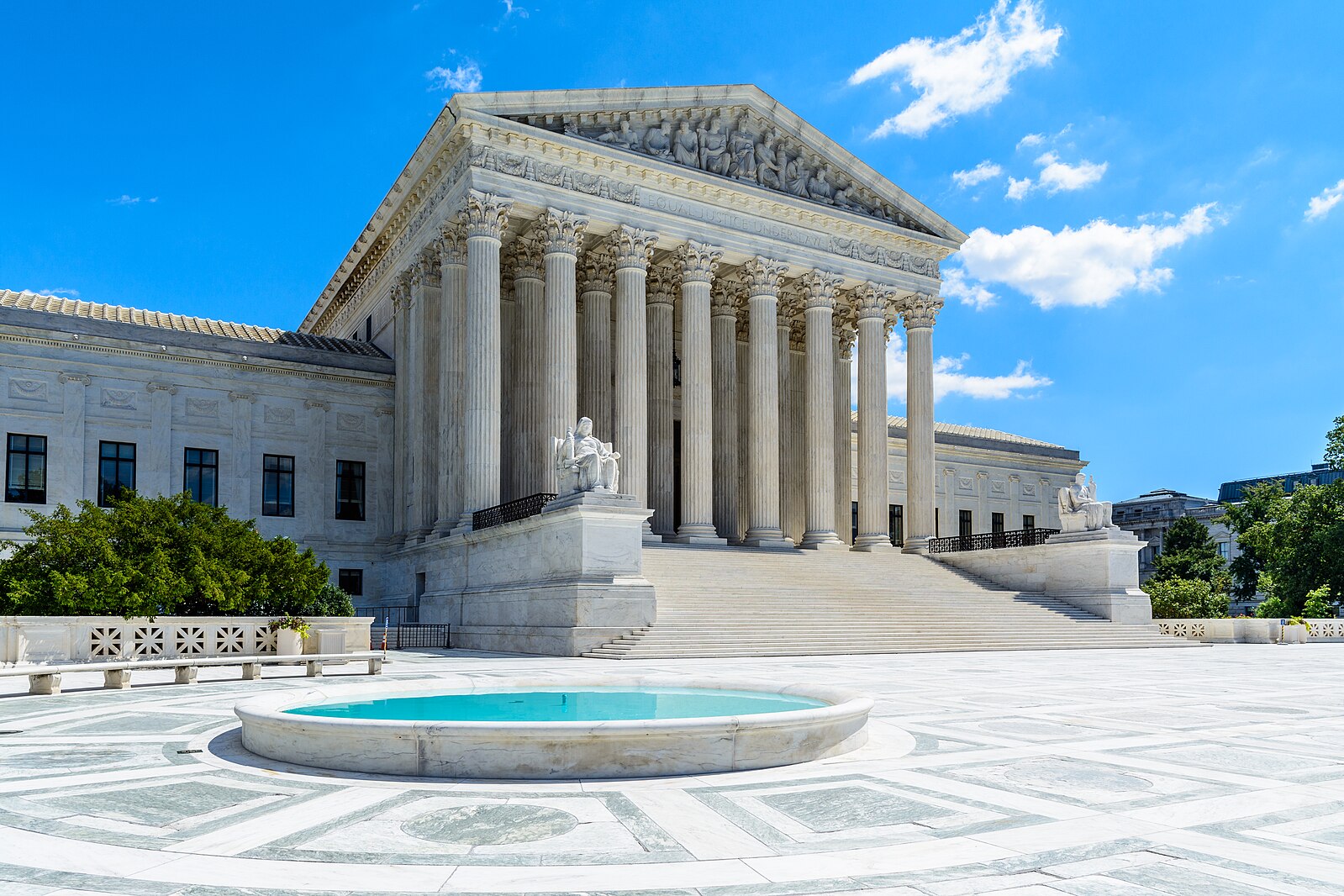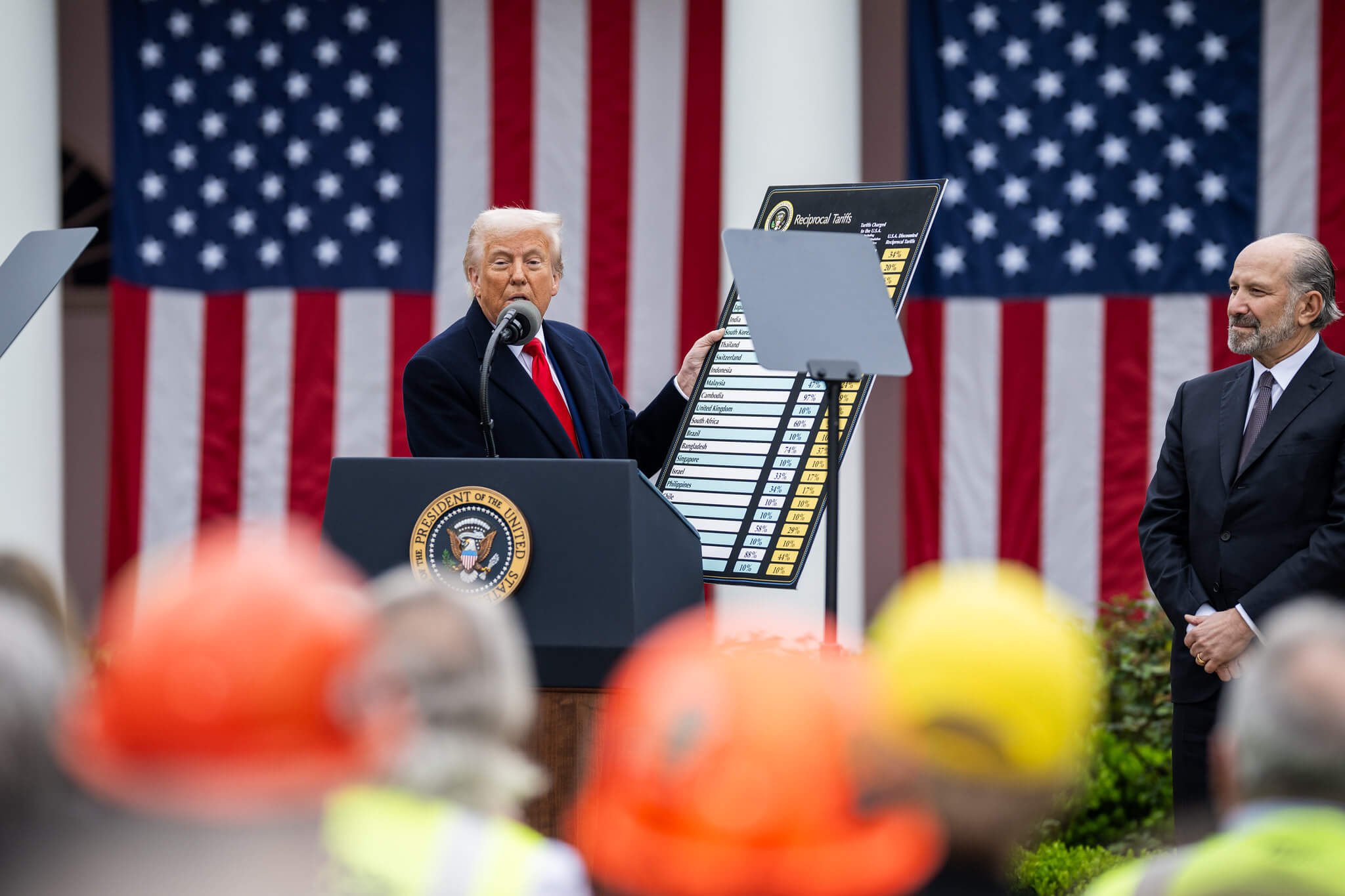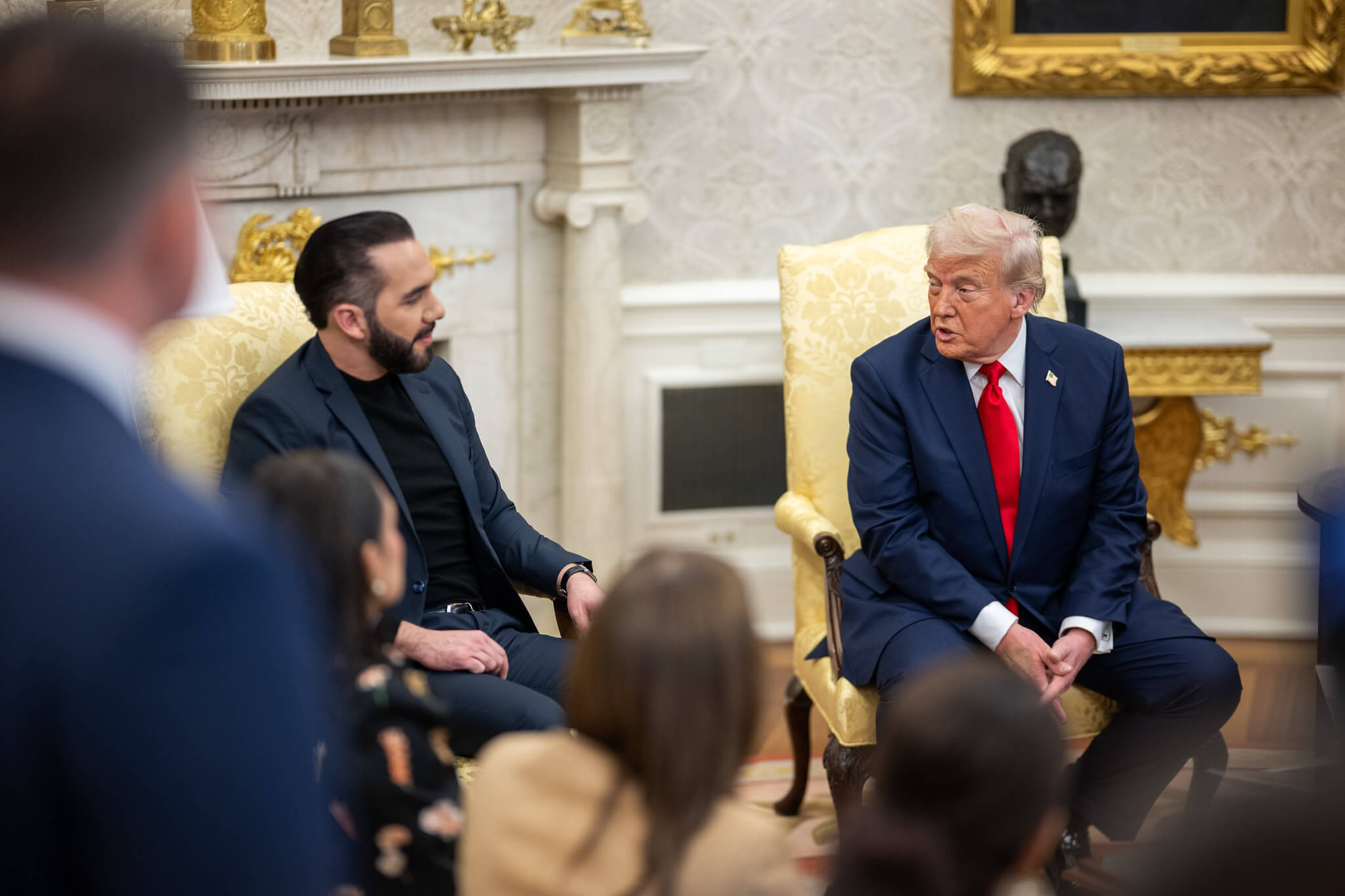Oral Argument Summary: Supreme Court Hears Gun Manufacturer Liability Case
The question at issue: whether U.S. firearms manufacturers can be held liable when Mexican cartels illegally purchase and violently use their firearms.

Published by The Lawfare Institute
in Cooperation With

Can American firearms manufacturers be held liable when Mexican cartels illegally purchase and violently use their firearms? That was the question before the Supreme Court on March 4, when the Court heard oral arguments in Smith & Wesson Brands, Inc., et al. v. Estados Unidos Mexicanos.
Mexico originally brought this civil suit against the firearms manufacturers on the claims that the manufacturers were responsible for supplying Mexican cartels with firearms because they manufacture and advertise firearms with a specific appeal to cartels and fail to stop the flow of firearms from their downstream dealers to cartels. Mexico’s suit alleges violations of U.S. tort and deceptive advertising law and the Gun Control Act of 1968. The gun manufacturers claimed immunity on the basis of the 2005 Protection of Lawful Commerce in Arms Act (PLCAA), which protects firearms manufacturers and sellers from qualified civil liability actions related to unlawful use of those firearms. The U.S. Court of Appeals for the First Circuit reversed the district court’s dismissal of the case and allowed the case to proceed.
The question for the court is whether Mexico can overcome the immunity shield created by the PLCAA by fitting its claims within a narrow exception that prohibits firearms manufacturers from claiming immunity if they have committed violations of state or federal law as applicable to the sale or marketing of firearms. Mexico argued that the manufacturers had violated 18 U.S.C. §§ 922(a)(6), (d)(1), 923(g)(1), and 924(a)(1)(A), and that this violation was a proximate cause for cartel violence committed in Mexico.
At oral argument, former Solicitor General Noel Francisco represented the firearms manufacturers, and Catherine Stetson represented Mexico.
Oral Arguments for Petitioners, Smith & Wesson Brands, Inc., et al.
Francisco argued that American gun manufacturers are not responsible for cartel violence in Mexico under the PLCAA because the line of causation between American firearms manufacturers and the cartels that use American-made firearms is a weak link, broken by multiple intervening independent crimes. He compared Mexico’s argument to the impractical notion that Budweiser could be held liable for every accident that underage drinkers cause, because the beer manufacturer must know that some alcoholic drinks ultimately end up in the possession of underage drinkers. Francisco further noted that the notion of an American company being held liable for the criminal acts of foreign nationals on foreign soil is unprecedented in American jurisprudence.
Francisco argued that Mexico was vague in identifying the statutory violation that would negate the PLCAA immunity shield. He claimed that Mexico’s complaint is attempting to use the federal aiding-and-abetting statute to establish liability for manufacturers but argued that the statute relies on the party’s knowledge that their actions were furthering a crime. Francisco argued that the manufacturers did not sell firearms with the knowledge that they would be used to further cartel violence in Mexico. Justice Elena Kagan pushed back on Francisco’s interpretation of the statute and argued that the manufacturers’ violation lies in the aiding and abetting of the retail sale to a straw purchaser. Francisco disagreed with Kagan and reiterated that the intervening crimes committed between the illegal retail sale and cartel violence in Mexico break the chain of causation needed to establish liability.
Chief Justice John Roberts asked Francisco to identify the role of foreseeability—the likelihood that a reasonable person would have been able to anticipate the potential consequences of their actions—in the proximate cause analysis. Francisco argued that foreseeability is a necessary condition but one that is insufficient unless there is also a direct relationship between the defendants’ actions and the violation of federal law that would negate the PLCAA immunity exception. Justice Amy Coney Barrett later pressed Francisco to identify where the violation of a statute relating to the sale or marketing of a firearm took place, and Francisco agreed that the retailer’s sale to a straw purchaser was the point at which such a statutory violation took place. Francisco cited the Court’s opinion in Hemi Group LLC v. City of New York, in which the Court held that an intervening crime broke the chain of causation; in the case at hand, he argued, there are “a multitude of intervening independent crimes.”
Justice Sonia Sotomayor focused on the violation cited in Mexico’s complaint: that the companies knew they were selling to straw purchasers. Francisco argued that the proximate cause analysis under the PLCAA starts with the companies’ manufacturing and distribution of firearms, not their alleged illegal sale to straw purchasers; imposing aiding-and-abetting liability for the latter, he argued, would essentially expose firearms manufacturers to liability for “every illegal retail sale in America.”
Justice Kagan asked Francisco to explain the structure of the industry and whether distributors are pass-through entities or independent ones. Francisco said the distributors are largely independent entities; manufacturers sell to distributors, who sell to retailers, he argued, and all are licensed entities. Kagan asked Francisco to elaborate on to what extent the manufacturers deal with retailers; Francisco noted that the industry follows a “tiered distribution chain” in which manufacturers are typically not dealing with retailers directly.
Justice Neil Gorsuch posed a hypothetical in which the manufacturers had actually aided and abetted the sale to “bad apple dealers, ones they knew or intended for them to sell on to people in Mexico doing bad things.” In that case, would the manufacturers’ actions be a proximate cause for establishing liability for cartel violence in Mexico? Francisco argued that even if the manufacturers could be held liable for the illegal retail sale to a straw purchaser, the intervening independent crimes—transferring the firearm from a straw purchaser to an actual purchaser, smuggling the firearm to Mexico—break the chain of causation, as per Hemi Group LLC v. City of New York, even if those intervening crimes are foreseeable.
Justice Kagan later asked whether a hypothetical manufacturer would be liable for aiding and abetting if it distributed directly to dealers and knew one of the dealers disproportionately sold to straw purchasers that facilitate firearms smuggling to Mexico. Francisco argued that if the manufacturer treated all retailers alike and would sell to any, even a “rogue dealer,” the manufacturer could not be held liable for aiding and abetting. Kagan then asked whether a company could be held liable if its products included certain characteristics that make firearms particularly useful for cartel members—for example, serial numbers that can be easily removed—noting that Mexico’s complaint appears to make such allegations. Francisco argued that manufacturing firearms “in a way that the general public likes” and treating buyers equally does not give rise to aiding-and-abetting liability.
Francisco compared the case at hand to Twitter, Inc. v. Taamneh et al, in which the Court determined that Twitter could not be held responsible for aiding and abetting terrorism when the Twitter algorithm recommends content from terrorist groups. In that case, Francisco said, there was both a specific criminal (ISIS) and a specific crime (the Reina nightclub attack). In contrast, he argued, Mexico’s complaint in this case “puts us on the hook for everything that the retailers are doing,” making this case more of a common law matter.
Justice Kentanji Brown Jackson said that the issue at hand is whether the companies proximately caused Mexican cartel violence such that the PLCAA’s exception applies and the companies can be held liable; it is not about aiding-and-abetting liability itself. Jackson also noted that the discussion of aiding-and-abetting liability in Twitter, Inc. v. Taamneh et al. was specific to the Justice Against Sponsors of Terrorism Act (JASTA) rather than the PLCAA, so the Court’s assessment of aiding and abetting may be different in this case.
Francisco disagreed with Jackson’s interpretation and noted that Twitter, Inc. v. Taamneh et al. still applied “traditional aiding-and-abetting principles,” but Jackson pushed back and argued that the approach to considering aiding-and-abetting liability may depend on statute itself, which requires an understanding of congressional intent behind the law. Francisco argued that “Congress’s entire purpose was to prohibit lawsuits just like this one,” referring to lawsuits brought by Chicago, Cincinnati, and Boston over similar matters. The PLCAA was designed to bolster the Second Amendment, he said, “by preventing plaintiffs from bankrupting the industry through frivolous lawsuits.”
Justice Gorsuch and Francisco then discussed several cases relating to aiding and abetting, including Direct Sales Co. v. United States and Rosemond v. United States; Francisco argued that both of those precedents required a level of intent and knowledge that exceeds what was present in the case at hand. Chief Justice Roberts referred back to the complaint’s citation that 2 percent of American-made firearms are eventually found in Mexico and asked Francisco if the percentage would alter his proximate cause analysis: iIf that number were 10 percent, 20 percent, or even 70 percent, would the analysis be different? Citing Hemi Group LLC v. City of New York, Francisco argued that the percentage would not matter for the proximate cause analysis because there were other intervening independent crimes that break the chain of causation.
Justice Barrett asked whether the Court should address proximate cause in addition to resolving the aiding-and-abetting question. Francisco responded that it should. Justice Jackson pushed back on Francisco’s suggestion of resolving aiding-and-abetting liability based on general common law principles, arguing that the interpretation should be made on a statute-by-statute basis, giving consideration to congressional intent in each of these statutes. Francisco refuted the statute-specific interpretation approach and argued that Congress would not have had a view of aiding and abetting that was inconsistent with the principles applied in Twitter, Inc. v. Taamneh et al, in which the Court had applied general aiding-and-abetting principles.
Francisco’s time concluded with a final exchange with Justice Jackson related to whether the proximate cause analysis should begin with the “first moment of illegality,” which was the sale from a retailer to a straw purchaser. Francisco disagreed with this outline of the proximate cause analysis and argued that this sale does not constitute a statutory violation for the manufacturers, because manufacturers do not sell directly to end consumers.
Oral Arguments for Respondent, Estados Unidos Mexicanos
Stetson argued that Mexico’s lawsuit falls squarely within the PLCAA’s predicate exception because it alleges gun manufacturers knowingly violated specific federal firearms laws that proximately caused harm to Mexico.
The PLCAA was originally passed in response to a series of lawsuits that sought to hold gun manufacturers and distributors liable for the damage of criminal gun use, based on their negligence in marketing and distribution. In light of this, Justice Clarence Thomas opened by asking how Mexico’s suit differs from the lawsuits that prompted the PLCAA’s passage. Stetson noted that “the types of suits that prompted PLCAA specifically did not allege that the manufacturers had violated any law.” She referenced the cases that prompted the PLCAA—namely the City of Philadelphia v. Beretta U.S.A. Corp. and McDonald v. City of Chicago—“specifically made the point that those manufacturers were not alleged to have violated any federal or state statute. They were being held liable for actions solely caused by criminals.”
Stetson directed the Court to the specific statutes the complaint alleges the defendants violated—18 U.S.C. §§ 922(a)(6), (d)(1), 923(g)(1), and 924(a)(1)(A)—emphasizing that these statutes are designed precisely to prevent guns from reaching criminals’ hands. Justice Thomas questioned whether the Bureau of Alcohol, Firearms, and Tobacco (ATF) had identified these violations and sought any kind of enforcement action. Stetson acknowledged they hadn’t, citing resource constraints, and noted that Congress deliberately chose not to require prior ATF action or convictions as prerequisites for suits under the exception in the PLCAA.
Discussion then turned to whether proving intent is necessary to show that defendants aided and abetted illegal firearms trafficking. Stetson cited Rosemond v. United States for the proposition that “[a] person who actively participates in a criminal scheme, knowing its intent and character, intends that scheme’s commission.” When Justice Gorsuch noted that criminal statutes require intent rather than mere knowledge, Stetson responded that “[i]f you actively participate knowing the scheme, then you can infer intent, particularly at the motion-to-dismiss stage.” Justice Sotomayor questioned whether such knowledge is present here, and Stetson directed the Court to the trace requests manufacturers receive from ATF alerting them “that guns they sell to specific distributors and dealers are being recovered at crime scenes” and to the fact that authorities “repeatedly identified and recovered defendants’ guns in connection with notorious gun trafficking rings.”
Later, Justice Jackson asked if Mexico accepts that the PLCAA’s statutory framework governs the case rather than common law aiding-and-abetting principles. Stetson agreed, pivoting—“I think the fact that we’re in a statutory scheme [is important in] centering this case where it is now. [... W]e are at the beginning of the beginning of this case.” At the pleading stage, they should be able to infer intent.
Even if one can infer intent based on knowledge, Justice Kagan noted that the complaint doesn’t state who the manufacturers are aiding and abetting. Stetson argued that specific dealers are identified by trace requests, which name specific distributor and dealer networks that were disproportionately associated with those guns. Justice Samuel Alito intervened, asking if there are “any allegations in the complaint that the [manufacturers] knowingly sell to specific red flag dealers?” Stetson responded that the complaint alleges that manufacturers have supplied dealers with “all the guns they can pay for” even if they have repeatedly violated gun trafficking laws, and have thereby demonstrated the active, culpable participation necessary for liability under Direct Sales.
Justice Barrett observed that unlike Direct Sales Co. v. United States and Twitter, Inc. v. Taamneh et al., Mexico hadn’t identified specific dealers that have sold guns in bulk to traffickers. Stetson countered that paragraphs 147-203 identify “specific dealers that have been found to have sold guns in bulk to traffickers that go across the border.” She argued that Direct Sales Co. v. United States actually provides stronger support for Mexico’s position: “The Direct Sales manufacturer did not know that that specific doctor was a problem ... unlike this case, where these manufacturers and the distributor are alleged to know who the dealers are and what problems they are causing.”
Justice Brett Kavanaugh expressed concern about economic implications: “Your theory of aiding-and-abetting liability would have destructive effects on the American economy ... lots of sellers and manufacturers of ordinary products know that they’re going to be misused by some subset of people.” Stetson took the opportunity to amend Francisco’s earlier analogy: “If Budweiser had a practice of selling bulk quantities of Bud Light to liquor stores arranged next to high schools and it was selling more and more into those high schools, knowing those liquor stores were regularly serving underage students, and, in fact, Bud Light designed a new can that says ‘Best Prom Ever’ and sold it right into that high school—that is the allegations in this case.”
Justice Alito followed up, asking if beer manufacturers should be liable for sales in college towns with high per-capita consumption. Stetson distinguished between general demographic awareness and specific dealer misconduct: “I don’t think that alone would be enough …. It would be you know the dealers are there, you know what they’re selling, you know who the bad apple dealers are …. We are talking about a small percentage of retailers responsible for about 90 percent of the crime guns.”
Later, Justice Kavanaugh returned to this concern with more specific examples, asking whether manufacturers of knives, baseball bats, or prescription drugs should avoid selling in neighborhoods where their products might be misused. Would manufacturers need to be “chasing—tracing everything down the chain” to avoid liability? Stetson distinguished between “general awareness” (insufficient under Twitter v. Taamneh) and “specific culpable participation.” When Kavanaugh pressed about baseball bat manufacturers who know their products are being used by gangs, Stetson first noted that “guns and drugs tend to be treated differently than things like knives and baseball bats.” She then provided a pharmaceutical analogy from the opioid cases: If a manufacturer sold prescription drugs to “a particular pharmacy in a small town at numbers that were simply unsustainable” and “continued to sell after being told by the federal government that you were selling into a rogue dealer,” then “yes, you would have a problem.”
Throughout, Stetson emphasized that “[w]e are at the beginning of the beginning of this case.” She explained that discovery would examine dealers’ knowledge and practices, such as selling “dozens of guns over a two-month period to the same person.”
Justice Jackson questioned whether the PLCAA statute itself expresses Congress’s intent that courts should not be crafting remedies that amount to industry regulation. Stetson responded that if the PLCAA had wanted to preclude all lawsuits against manufacturers, it could have done so—as many states did. Instead, it carefully carved out exceptions for cases where manufacturers are alleged to have broken the law.
Chief Justice Roberts pressed Stetson on the significance of Mexico’s claim that 2 percent of U.S.-manufactured guns end up in Mexico, asking where the statistical floor might be for establishing liability. Stetson pivoted from the percentage question, arguing that what matters most is manufacturers’ knowledge of specific problematic dealers: “The issue is not so much whether it’s 2 or 10 or 70. It’s do these manufacturers know who the rogue dealers are and what they’re doing.” She emphasized that the complaint alleges manufacturers have trace data showing bulk sales to traffickers who repeatedly bring guns into Mexico.
When Roberts challenged Mexico’s emphasis on gun designs with Spanish names and patriotic symbols—features that aren’t illegal—and questioned whether manufacturers should stop producing legal firearms that might disproportionately end up in Mexico, Stetson clarified that the issue was intentional targeting: “It’s not so much that the defendants are designing a particular gun. It’s that they are designing certain guns to target the Mexican market, including the cartels.” She cited Colt’s “Super El Jefe,” “Super El Grito,” and “Emiliano Zapata 1911” models as examples of firearms “coveted by the cartels” and “smuggled into Mexico in volume.”
Finally, Justice Alito asked whether Mexico would accept being sued by American states over border crossings. Stetson carefully noted that “under Pfizer, Mexico is entitled to come in—and the Petitioners’ own amici point this out—to come into this case just like any other litigant.” She avoided making concessions about sovereign immunity while emphasizing that when a sovereign appears as plaintiff, “it is treated exactly like any other plaintiff, no more, no less.”
Rebuttal Arguments for Petitioners, Smith & Wesson Brands, Inc., et al.
Francisco argued that if the Court were to accept Mexico’s interpretation of the PLCAA and its immunity exception, thereby permitting gun manufacturers to be held responsible for downstream violence, the Court would be encouraging the same type of tort lawsuits that the law was designed to prohibit. Mexico’s allegation, he said, is that the manufacturers sell to all federal firearm licensees; Francisco notes that the allegation is that the manufacturers are treating all retailers exactly the same. This equal treatment, he argued, would not meet the threshold for aiding-and-abetting liability, as it did not in Twitter, Inc. v. Taamneh et al., and Mexico’s allegation that knowledge of the illicit conduct is sufficient to impose liability was also rejected by the court in Twitter, Inc. v. Taamneh et al.
Francisco also rejected Mexico’s argument that intervening acts did not break the chain of causation because those acts were foreseeable; he argued that this breaks with the court’s standard that intervening independent acts break the chain of causation, as affirmed in Hemi Group LLC v. City of New York and Lexmark Int’l, Inc. v. Static Control Components. Turning to his conclusion, Francisco underscored that the intent of the PLCAA was to protect Second Amendment rights by protecting the right of manufacturers, retailers, and distributors to sell firearms; allowing future petitioners to bring these civil liability cases would undermine the intent of the PLCAA, which was designed to restrict liability for the firearms industry.






